Court Baroness Scroll based upon
The Sforza Hours
Marko Evanovich Panfilov
Barony of Dragonsspine, Kingdom of the Outlands, December 12th, A.S. 38 (2003)

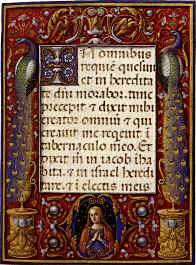

|
Court Baroness Scroll based upon
The Sforza Hours |
|
|
This scroll is based upon the style of The Sforza Hours, a personal Book of Hours commissioned by Duchess Bona Sforza of Milan, Italy, late in the 15th century. Bona was originally from Savoy. Her nephew, Charles I of Savoy, had recently commissioned the Tres Riches Heures, and forty years earlier Duke Visconti of Milan had commissioned The Visconti Hours. As an admirer of such works, Duchess Bona wished an equally extravagant Book of Hours for herself, resulting in The Sforza Hours. This extraordinary manuscript was the work of Giovan Pietro Birago, and according to letters recovered from the period, part of the manuscript was stolen and never recovered. Only many years later were the stolen folios replaced by subsequent artists. The original manuscript now resides in the British Library and is discussed in The Sforza Hours published by the British Library. This scroll was created in November, A.S. 38 (2003) for Coronation and awarded to Anne Bigod as a Baroness of the Court.
The scroll is a combination of two folios from the Sforza Hours. Fol. 54r depicts a female saint and peacocks with a red and gold border. Fol. 258r depicts a cherub holding a skull and has a similar red and gold border style. Unlike much of the work during this period in Italy, which consisted of realistic flowers and bugs on a gold background, most of the illuminated borders of the Sforza Hours used gold and ochre over a background of red and blue. Several of the pages also had gold letters over a blue background as shown in the second folio above. All of these elements were combined into a single red and gold scroll, with the gold letters on blue background for the initial sentence, and the picture of the female saint replaced with the recipients arms (to be completed when her arms, which are in submission, are approved by the College of Heralds).
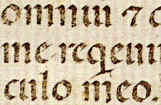 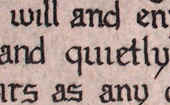 |
The hand used in the Sforza Hours is Italian Rotunda. Rather than using a modern exemplar, I attempted to copy the precise hand used in the original manuscript. The spacing was also reproduced, with the space between lines equal to the height of the letters. A somewhat thicker nib could have been used, but otherwise I am pleased with the result. |
| Figure 1. Left: Calligraphy from the Sforza Hours. Right: Calligraphy from the scroll. | |
The original manuscript was likely created using cut quills, usually from a goose, dipped in iron gall ink and written on vellum made from calfskin. Due to the high cost of calfskin vellum, modern Pergamenata paper was used instead. Having worked on actual vellum, I can personally attest to the fact that Pergamenata retains many of the qualities of vellum. In particular, ink and paint stay on the surface of the vellum instead of soaking in as with modern paper. Mistakes can be easily corrected by scraping the ink or paint with a sharp pen knife. A metal nib dip pen was used in place of the quill to avoid the constant sharpening needed by quill pens. Permanent light-fast black ink was used for archival purposes instead of the period ink that is brown and turns black as it oxidizes.
  |
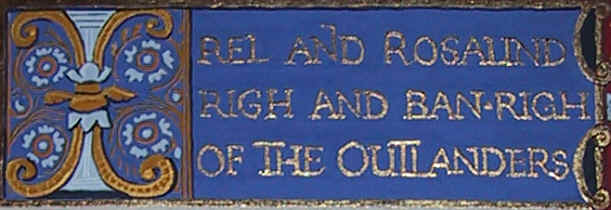 |
| Figure 2. Top: Illuminated 'I' and lettering from the Sforza Hours. Bottom: Illuminated 'I' and lettering from the scroll. |
|
Gold leaf was applied to the letters in
the header and to the border of the scroll. In period, a gesso made of slaked plaster, sugar,
hide glue (or fish glue), and white lead would have been used. In the dry climate of Colorado,
such a mixture does not work consistently, so a modern substitute of acrylic gloss
medium (sometimes called Hyplar) was used instead. Blowing gently on the dried
acrylic size makes it tacky, and gold leaf is carefully laid over the surface
and burnished until shiny. The rest of the border is painted in an ochre
color to match the hue of the gold and is highlighted with gold gouache. The
original likely used shell gold in some areas and ochre colored paint in other
areas. Without access to the original it is difficult to determine its exact composition.
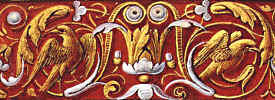 
Figure 3. Left: border from the Sforza Hours. Right: border from the scroll. |
||
 
|
The borders of the selected folios are
decorated with pillars, vines, flowers, and birds, mostly in a gold color
over a red background. A light table was used to transfer the
designs to the scroll, which were then painted using gouache.
By far the most difficult part of the scroll was the shading of the borders. While I've done many scrolls involving white-work shading, this is my first attempt at dark shadowing. While white-work is typically a very wet process involving blending white with the existing layer of gouache, shadowing is a very dry process. First, the layer of ochre gouache was painted. Then the red background was painted. Next, the red was darkened with it's secondary color of green to achieve the dark brown color for the shadows. Shadows to the right and bottom of each leaf, flower, and other decoration were then applied lightly using a dry brush. The same color was used for the shadows on the ochre pillars. Fine lines of the same dark brown were then used for the details. Finally, bright gold gouache was used for highlighting. The same technique was used for the green, blue, and white areas on the scroll. This was a meticulous and time consuming process, but I am very pleased with the results. |
 
|
| Figure 4. Top: border from the Sforza Hours. Bottom: border from the scroll. | ||
Paints were made in the Middle Ages by dissolving various pigments into a binder, such as gum arabic or egg yolk. However, many of these pigments were highly toxic. For example, red paint contained lead or iron. Yellow was made from orpiment, which contained arsenic oxide. Verdigris green contained copper and strong vinegar, or malachite. Because of the toxic nature of these pigments, modern gouache was used. Although the actual chemicals are different and safer, gouache still consists of finely powdered pigments mixed with a binding agent. In some cases, such as Ultramarine, the chemical composition is identical to the period pigment.
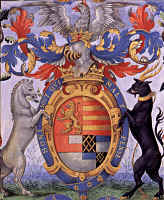  |
The achievement comes from the Psalter of the Earl of Arundel, England, 1565, and depicts the arms of Henry Fitzalan, Earl of Arundel. It is a beautiful example of tri-colored mantling and is from the time and place of the recipient's persona. It also happens to be of the same time period as the Sforza Hours. The supporters and crest were removed and the crown was replaced with a baronial coronet. The helm was copied directly from the original, and gold leaf was applied to the visor and to the coronet. The shield has been left blank to be replaced with the recipient's arms once they are approved. The arms submitted by the recipient are black, white, and gold, so the mantling was colored, although only roughly shaded in case the colors need to be changed. |
| Figure 5. Left: arms of the Earl of Arundel. Right: achievement of arms from the scroll. | |
The text used for the scroll was provided by Countess Aindrea Mac Cullaich and is based upon a period text used by Henry I to grant Hugh Bigot his Earldom. The original, dated from between 1154 and 1189, is reproduced here, followed by the actual text used in the scroll:
Henry, King of the English, Duke of Normandy and Aquitaine and Earl of Anjou.
To Archbishops, Bishops, &c. and all his faithful men both French and English of the whole of England and Normandy, greeting.
Know that I have made Hugh Bigot, Earl of Norfolk, that is to say, with the third penny of Norwich and Norfolk, and I will and enjoin that he and his heirs shall hold as freely and quietly and honourably of me and my heirs as any other Earl well and freely holds his Earldom.Irel and Rosalind, Righ and ban-Righ of the Outlanders.
To Peers, Nobles, &c. and all their faithful subjects, greeting.
Know that we have made Anne Bigod, Baroness of our Court, that is to say, bestowing with it a Grant of Arms, and we will and enjoin that she shall hold as freely and quietly and honourably of us and our heirs as any other Baroness well and freely holds her rank and title.
Having previously done several scrolls based upon The Visconti Hours, it was humbling to attempt to match the style of this later Italian masterpiece. The realism in the portraits and illumination throughout the Sforza Hours is remarkable and very difficult to reproduce. I'm happy that my attempt at least harkens to the original even though it's impossible to match the originals workmanship. It is no surprise that, according to the recovered letters from the period, this manuscript cost many times what Leonardo da Vinci's works were valued.